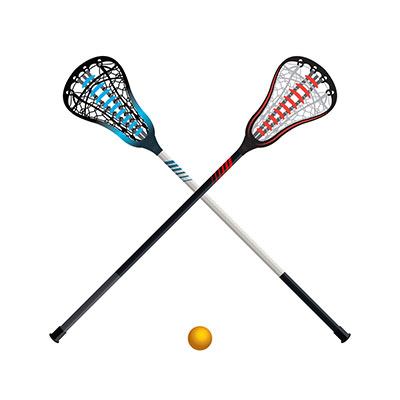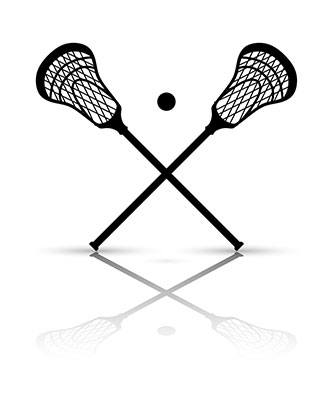Do you want to improve your lacrosse game? If so, it all starts with having the proper technique.
Knowing how to hold lacrosse stick is essential for any player. It provides an extra boost in speed, strength, and accuracy when passing or shooting.
Whether you're a veteran athlete or just starting in the sport, specific tips must be followed if you wish to master the art of handling your stick correctly.
Please read below as we share our knowledge on safely practicing this fundamental skill.
More...
Take Away Key Points:
If you're unsure how to hold a lacrosse stick correctly, find the techniques below to help you find the best method for practicing the skill.
Where to Hold Lacrosse Stick? The Proper Position for Right-handed Players
Lacrosse players use their dominant hand to generate hotting power, control stick movements, and protect the ball as it cradles in the head netting.
If you're a right-handed lacrosse player, you hold the bottom of the stick with your non-dominant hand for stability and slide the dominant hand along with the stick shaft, depending on the match situation.
Below is an excellent exercise to practice holding the stick properly and learn the fundamentals of the game.
1. Ready position

The position is suitable for practicing passing, moving without the ball, or shooting.
1. Position your left hand on the handle directly above the butt end of the lacrosse stick. Next, place your thumb toward the stick head.
2. Place your right hand one-third of the way up to the stick handle. Your hand should be around shoulder distance from your left hand. Place the thumb toward the stick head.
3. Grasp the lacrosse stick with both of your hands. You should curl your hand around the stick handle to rest on the pads of your fingers.
4. Press your thumb against the lacrosse stick shaft.
5. Bend your right arm at the elbow.
6. Hold the stick at your eye level. The lacrosse head should be facing forward.
2. Scoop position
The technique is used to pick up the ground balls with your stick and gain possession of the lacrosse ball.
1. Slide your right hand up the lacrosse shaft to the stick throat when approaching the ground ball. The stick throat is located a few inches below the lacrosse head.
2. Run to the ball, ensuring your right foot is next to the ball.
3. Bend down, lean forward, and rotate your wrist. The action will invert the lacrosse stick head, similar to a spoon.
4. Scoop the lacrosse ball off the ground and scoop it into the stick head. Protect the lacrosse ball from defenders by switching to the cradling technique. You can also switch to the ready position for passing or shooting the ball.
3. Cradling technique
The cradling position refers to rotating the lacrosse stick in half-turns while the ball is inside the pocket. Lacrosse players hold the stick nearly upwards as they run. If you've ever wondered how to cradle a lacrosse ball, below is the procedure:
1. Slide your hand up the lacrosse shaft to the stick throat to protect the lacrosse ball in the net.
2. Grasp the stick throat firmly between your forefinger and thumb.
3. Slide the left hand down the lacrosse shaft until you reach the butt end with your palm facing the ground.
4. Rotate your wrist back and forth, and keep your left arm close to your body. The cradling movement protects the ball inside the net while players play against defenders.
Why do lacrosse players twist their sticks?
Lacrosse players twist the sticks to prevent the ball from falling off the netting after they have caught the rolling ball on the ground. The cradle practice is ideal for keeping possession, passing, or firing the ball later.
4. Catching movement
For successful catching, your top hand must be next to the head of the lacrosse stick, as this makes catching much easier.
In addition, players should throw and catch the ball with both the dominant hand and the non-dominant hand to gain more control of the ball.
If a player cannot catch with their non-dominant hand and relies on the dominant hand more, he cannot be a part of an advanced lacrosse team.
Follow the procedure below for a better understanding:
1. Slide your right hand up the lacrosse shaft to the stick throat. Your bottom hand should reach the butt end of the lacrosse shaft.
2. You should grip the stick with both hands, similarly to the grip used in the ready position.
3. Keep your left arm close to your body as the ball approaches.
4. Guide the stick head with your right hand to match the ball's path.
5. As the ball strikes the netting, you should pull back slightly with your right wrist to cushion the impact and gain ball control.
How to Make the Stick Grip More Comfortable?

A lacrosse stick might often be slick, especially when it's raining or wet outside. An extra issue is that you're wearing your gloves, so the shaft is even slicker. However, taping might be an effective solution to this problem.
Taping your stick adds a more comfortable grip to your arms, and you can have a better handle on the stick. You can also improve the power you get when shooting.
Various players state taping can also serve as a teaching aid. So, putting the tape around the bottom part of the stick where your lower hand holds it provides a better grip when holding the stick at the bottom.
In addition, you can, for example, tape the part of the stick that you're holding with your top hand when catching or throwing the ball. Thus, your hand will find precisely where it must be to throw, pass, catch, or shoot the ball.
You can tape the stick in box lacrosse as well.
Frequently Asked Questions
Where should your dominant hand be on a lacrosse stick?
If you're cradling, place your dominant hand on the top of the lacrosse shaft. Next, place your non-dominant hand at the butt end - the bottom part of the lacrosse stick. This way, you will protect the whole shaft from checks and finish the cradling process successfully.
What are 3 tips for cradling in lacrosse?

The three tips for cradling in lacrosse are the following:
- create a pocket for cradling
- perform basic cradling operations
- switch sides.
However, there are two additional target tips, including:
- cradling with one hand
- passes and shots
How do I improve my weak hand in lacrosse?
To improve your weak hand in lacrosse, you must constantly repeat your practice. Repetition is generally an excellent equalizer in lacrosse. With constant practice, you will build more strength in your weak hand and become more comfortable with every sway of the lacrosse stick.
How to add hold to a lacrosse stick?
To add hold to your lacrosse stick, you should practice quick stick shots close to the goal. You should also run, scoop the ground ball, shoot, and repeat the process. You can also Run from the back of the goal - the X position, and shoot both sides - left and right.
Summary
There are a lot of factors that affect your game when playing lacrosse. One of the most important is how you hold your stick. There are different techniques and drills to help you master the perfect grip.
Try various methods on how to hold lacrosse stick until you find one that is comfortable for you.
The more time you spend practicing, the better your grip will be and the easier it will be to control the stick during a game.
